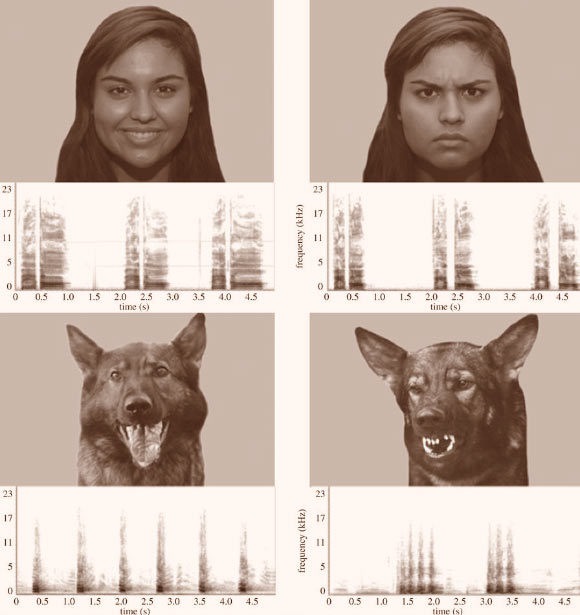Dogs can recognize emotions in both dogs and humans by combining information from different senses, according to a study published today in the journal Biology Letters.

Examples of stimuli used in the study: faces (human happy versus angry, dog playful versus aggressive) and their correspondent vocalizations. Image credit: Natalia Albuquerque et al.
The authors – a team of researchers from the University of Sao Paulo in Brazil and the University of Lincoln in UK – presented 17 domestic dogs with either human or dog faces with different emotional valences (happy/playful versus angry/aggressive) paired with a single vocalization from the same individual with either a positive or negative valence or Brown noise.
These distinct sources of sensory input – photos of facial expressions and audio clips of vocalizations (voices or barks) from unfamiliar subjects – were played simultaneously to the animals, without any prior training.
“Dogs looked significantly longer at the face whose expression was congruent to the valence of vocalization, for both conspecifics and heterospecifics, an ability previously known only in humans,” the scientists said.
The integration of different types of sensory information in this way indicates that dogs have mental representations of positive and negative emotional states of others.
“The perception of emotional expressions allows animals to evaluate the social intentions and motivations of each other. This usually takes place within species; however, in the case of domestic dogs, it might be advantageous to recognize the emotions of humans as well as other dogs,” the researchers said. “In this sense, the combination of visual and auditory cues to categorize others’ emotions facilitates the information processing and indicates high-level cognitive representations.”
“Previous studies have indicated that dogs can differentiate between human emotions from cues such as facial expressions, but this is not the same as emotional recognition,” said University of Lincoln scientist Dr Kun Guo.
“Our study shows that dogs have the ability to integrate two different sources of sensory information into a coherent perception of emotion in both humans and dogs.”
“To do so requires a system of internal categorization of emotional states. This cognitive ability has until now only been evidenced in primates and the capacity to do this across species only seen in humans.”
“It has been a long-standing debate whether dogs can recognize human emotions. Many dog owners report anecdotally that their pets seem highly sensitive to the moods of human family members,” added Prof. Daniel Mills, also from the University of Lincoln.
“However, there is an important difference between associative behavior, such as learning to respond appropriately to an angry voice, and recognizing a range of very different cues that go together to indicate emotional arousal in another.”
“Our findings are the first to show that dogs truly recognize emotions in humans and other dogs.”
_____
Natalia Albuquerque et al. 2016. Dogs recognize dog and human emotions. Biol. Lett., vol.12, no. 1; doi: 10.1098/rsbl.2015.0883







